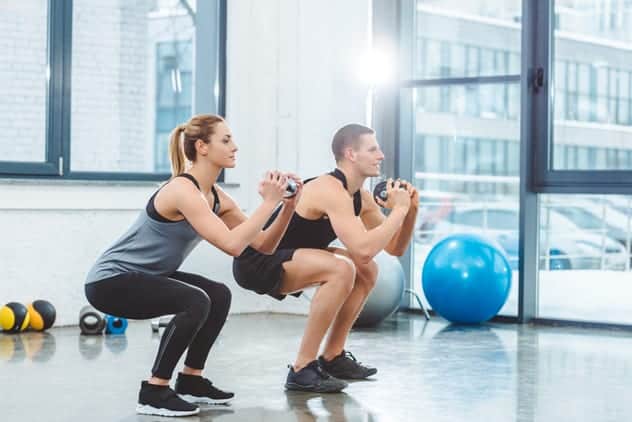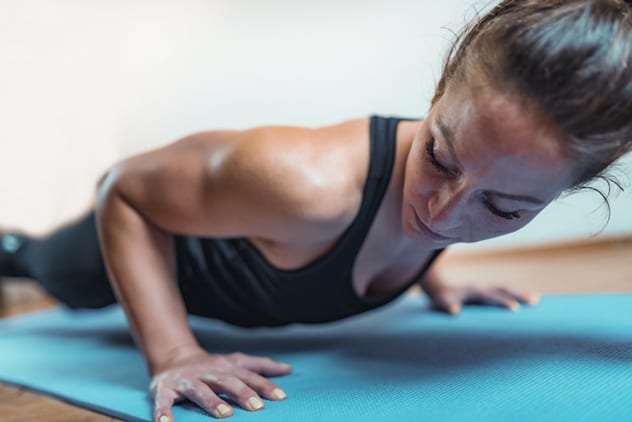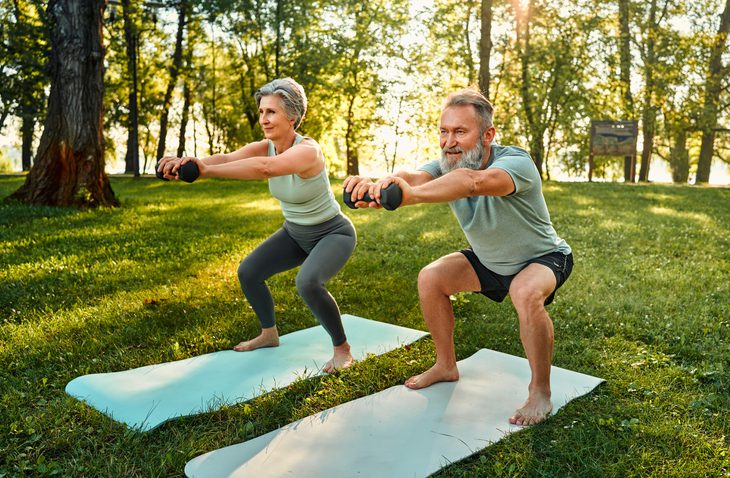Functional training: It pretty much does what it says on the tin.
It’s meant to be, you guessed it, functional.
In other words, it’s designed to be relevant to everyday life and give your exercise routine more “purpose”.

Functional training incorporates the types of movements you use day-to-day and is nothing like traditional machine-based gym workouts.
So think squats, deadlifts and lunges rather than leg presses, bicep curls or pulldown machines.
But don’t for one second think that a functional training programme will go easy on you. If you want it to, it’ll push you to your limits.
And if you’re looking for help incorporating exercise into your daily routine, here are seven handy tips.
So what is functional training?
You may have noticed the word “functional” pop up in descriptions for group fitness classes at your local gym.
It’s even in the name of one of the biggest fitness trends out there: that “F” in “F45” stands for “functional”.

The movements involved tend to get the whole body moving as opposed to isolating particular muscles.
They are designed to imitate everyday movement patterns with compound exercises – such as squatting, pushing, pulling and rotating – but it’s done to a level and a structure that will ensure you get a serious sweat on.
Tara Teakle head of F45 at a gym in Brooklyn told Self.com, “For example, think of the leg extension machine,” she says. “You’re never going to just use your quads. [Functional training] works with the glutes, hamstrings, and core.”
The types of exercise you can expect to follow as part of a functional training programme are squats, deadlifts, kettlebell swings, push-ups, burpees and various types of lunges.
Depending on the workout, they can be incorporated into a high-intensity interval training (HIT) workout, which will push you to your physical and mental limits like F45, or they can form part of a lighter, scaled-back workout.
How can I try functional training?
Your local gym will almost certainly have a group class that has functional training as its primary goal.
However, there are countless exercise routines you can find online to try on your own or with friends.
Note that some routines will require a small range of equipment such as free weights, kettlebells or Swiss balls.
If you do include some weight and resistance training in your workout, here’s why your heart will really thank you for it.
However, there are plenty of workouts that don’t require any equipment at all. Using just you and your own bodyweight – meaning you can get “functionally” ship-shape at home or in the park.
Top 10 Functional Training Exercises for Total Fitness
- The King’s Climb: Begin your journey to total fitness with “The King’s Climb.” This exercise challenges you to conquer steep, rocky terrain, mirroring the determination required to achieve your fitness goals. It’s not just about physical prowess; it’s about the mental fortitude to overcome obstacles.
- The Urban Jungle Sprint: Navigate the bustling streets in “The Urban Jungle Sprint.” This exercise mimics the agility and speed of a jungle cat as you dash through city streets, dodging pedestrians and skillfully maneuvering around urban obstacles. It’s a true test of your cardiovascular endurance.
- The Bridge of Balance: Achieve balance, both physically and mentally, in “The Bridge of Balance.” This exercise requires you to walk across a narrow, swaying footbridge over a tranquil pond. It’s a lesson in focus, stability, and maintaining equilibrium.
- The Park Bench Press: Central Park becomes your training ground with “The Park Bench Press.” Using the park’s benches, perform modified bench presses that target your upper body and core. It’s a unique blend of strength training and outdoor fitness.
- Skyline Lunges: Challenge your leg muscles and stamina with “Skyline Lunges.” Ascend staircases leading to scenic viewpoints that offer breathtaking city views. This exercise combines lower body strength with the rewards of panoramic vistas.
- River Rowing: In “River Rowing,” you’ll experience the full-body workout of rowing along the tranquil river within the city. This exercise enhances your cardiovascular health while building strength in your arms and back.
- Parkour Playground: Embrace your inner urban ninja in the “Parkour Playground.” Navigate the city’s urban landscape, using walls, railings, and obstacles as your canvas for artistic and athletic expression. This exercise combines strength, flexibility, and agility.
- Metropolitan Plank Challenge: Take the “Metropolitan Plank Challenge” to the heart of the city. Engage your core and challenge your endurance while planking in iconic urban locations, from rooftop gardens to bustling street corners.
- Street Yoga Serenity: Find your inner peace amidst the city’s hustle and bustle with “Street Yoga Serenity.” Perform yoga poses in urban oases, parks, and rooftop gardens. This exercise blends physical fitness with mental tranquility.
- Sunset Stretch by the Skyscrapers: Conclude your fitness journey with a calming “Sunset Stretch by the Skyscrapers.” Unwind with yoga stretches against the backdrop of the city’s towering skyscrapers, promoting flexibility and relaxation.
Why should I give functional training a try?
Functional training can really improve your fitness, coordination, focus core strength and stability.
Not to mention other benefits such as good heart health and lowering blood pressure and cholesterol.
It engages different muscle groups all at once so, without fail, you’re giving yourself a full-body workout.
Functional training also improves your “kinesthetic” awareness. This means awareness of how your body moves as one unit and can also be a great fat-burning regime.
More than anything, remember that it’s designed to be “functional” for your everyday life.
So if you feel that running for the bus, lifting a heavy suitcase or bending over to pick something up leaves you out of breath or in pain, then functional training will really help you.
And finally, the “I’ve got no time for the gym” excuse is no longer valid:
You can smash a worthwhile functional training workout in as little as 20 minutes, so there’s no reason not to give it a go.







